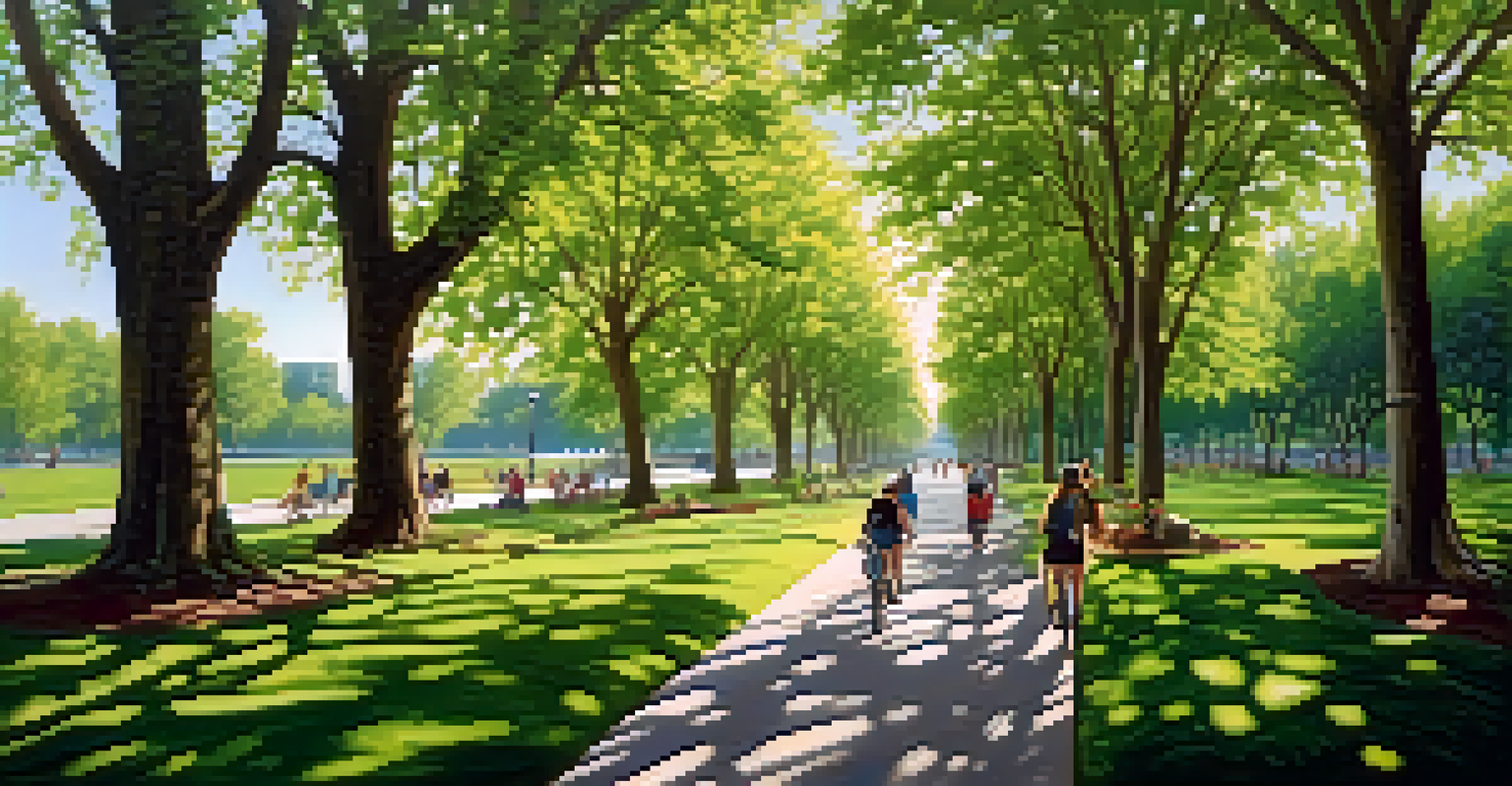The Role of Green Spaces in Supporting Urban Wildlife

Understanding Urban Wildlife and Its Needs
Urban wildlife encompasses various species that have adapted to city environments. These creatures, from birds to small mammals, require specific habitats to thrive. In bustling cities, finding suitable shelter, food, and water can be challenging for them.
In every walk with nature, one receives far more than he seeks.
Understanding their needs is crucial for maintaining biodiversity in urban settings. For instance, many birds require trees for nesting and safe places to find food. Without appropriate green spaces, urban wildlife may struggle to survive.
By recognizing these needs, city planners and residents can work together to create environments that support local wildlife. This collaboration is vital for fostering a healthy ecosystem, benefiting both animals and humans.
The Importance of Green Spaces in Cities
Green spaces, such as parks, gardens, and green rooftops, play a pivotal role in urban ecosystems. They provide essential habitats for wildlife, offering food sources and shelter. These areas act as critical corridors that allow animals to navigate through urban landscapes.

Moreover, green spaces help improve air quality and reduce urban heat, creating a more livable environment for both wildlife and humans. For example, parks filled with native plants attract pollinators like bees and butterflies, promoting biodiversity.
Urban Wildlife Needs Green Spaces
Creating green spaces in cities is crucial for providing habitats, food, and water for urban wildlife.
In essence, these green areas serve as vital sanctuaries for urban wildlife, helping maintain ecological balance. Their preservation and expansion should be a priority for city planning efforts.
Enhancing Biodiversity Through Native Plants
Using native plants in urban landscaping can significantly enhance local biodiversity. Native flora is well-suited to the local climate and soil conditions, providing the right resources for native wildlife. This means more food and shelter for species that are already part of the ecosystem.
The greatness of a nation and its moral progress can be judged by the way its animals are treated.
For instance, planting native wildflowers can attract various pollinators, while native shrubs offer nesting sites for birds. Such plants also require less water and maintenance, making them a sustainable choice for urban environments.
By prioritizing native plants, cities can create thriving habitats that support a diverse range of wildlife. This not only benefits the animals but also enriches the urban experience for residents.
Urban Green Corridors: Connecting Wildlife Habitats
Urban green corridors are essential links that connect fragmented habitats, allowing wildlife to move freely within cities. These corridors can take the form of parks, greenways, or even tree-lined streets. They facilitate animal movement and genetic exchange, which is vital for species survival.
For example, a well-planned green corridor can enable animals like raccoons and foxes to travel safely through urban landscapes without facing significant hazards. These pathways can also help mitigate the effects of urban sprawl by providing refuge for wildlife.
Native Plants Boost Local Biodiversity
Using native plants in urban landscaping enhances biodiversity by offering essential resources for local wildlife.
Creating and maintaining these corridors requires thoughtful urban planning and community involvement. By integrating green corridors into city designs, we can foster a more interconnected ecosystem.
The Role of Community Gardens in Supporting Wildlife
Community gardens are a fantastic way to support urban wildlife while promoting community engagement. These spaces often feature a diverse array of plants, which can attract various species, from pollinators to small mammals. They also serve as educational platforms for residents to learn about local ecosystems.
For instance, a community garden with flowering plants can provide abundant nectar for bees, while vegetable patches may attract birds looking for insects. Additionally, these gardens can create microhabitats that support soil health and water retention.
By encouraging residents to cultivate community gardens, cities can foster a sense of ownership and responsibility towards local wildlife. This involvement can lead to greater awareness and appreciation of the natural world.
Challenges Faced by Urban Wildlife in Green Spaces
While green spaces offer refuge for urban wildlife, they come with their own set of challenges. Habitat fragmentation, pollution, and human encroachment can threaten these areas, making it difficult for wildlife to thrive. For example, busy roads can create dangerous barriers for animals trying to cross to find food or mates.
Additionally, invasive species may compete with native plants, disrupting the delicate balance of these ecosystems. This competition can lead to a decline in native wildlife populations, further exacerbating the problem.
Community Engagement Supports Wildlife
Community gardens foster engagement and create habitats that benefit urban wildlife while educating residents.
Addressing these challenges requires ongoing awareness and action from both policymakers and the community. By protecting and enhancing green spaces, we can mitigate these threats and support urban wildlife.
The Future of Urban Green Spaces and Wildlife
Looking ahead, the future of urban green spaces will play a vital role in supporting wildlife. As cities continue to grow, integrating more green areas can help create sustainable environments for both humans and animals. This includes innovative solutions like green roofs and vertical gardens that maximize limited space.
Moreover, public awareness campaigns can educate residents about the importance of green spaces for wildlife. Encouraging participation in local conservation efforts can empower communities to take action, making a positive impact on their surroundings.

Ultimately, the future hinges on collaboration between city planners, ecologists, and residents. Together, we can create urban landscapes that celebrate and support the rich diversity of wildlife.